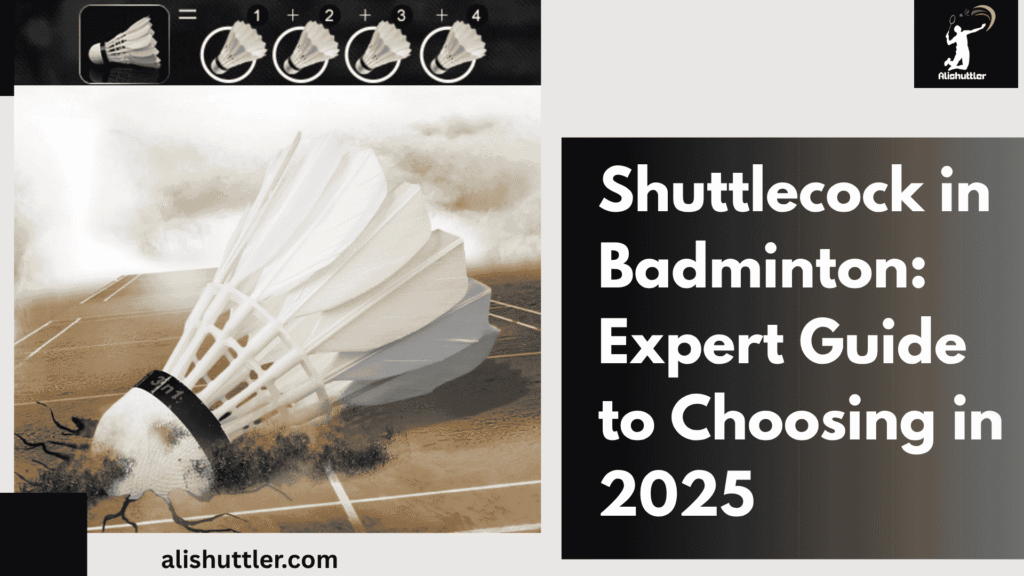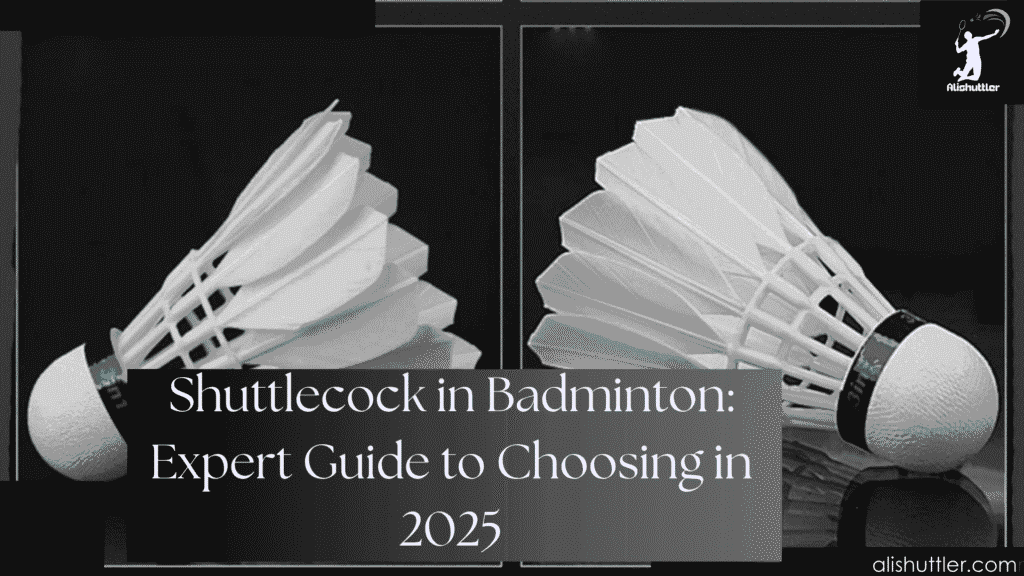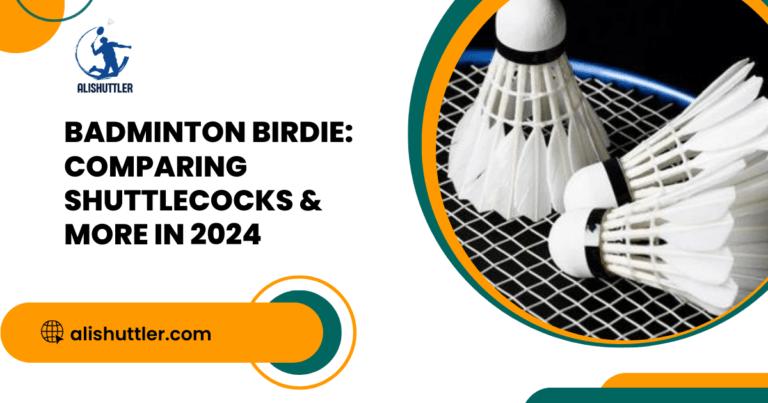A shuttlecock in badminton is the projectile that players hit across the net. Constructed of feathers or synthetic materials, it features a rounded base of cork and a cone shape.
Weighing approximately 4.75–5.50 grams, the shuttlecock is extremely light and its design gives it the ability to have a trajectory that is both straight and rapidly decelerating.
Understanding the shuttlecock’s anatomy and function allows players to select the appropriate one.
Shuttlecock Anatomy
A badminton shuttlecock is a crucial component of badminton, composed of a cork base and skirt. Every component affects shuttlecock speed, flight, durability, and playability. Understanding what makes up a feather shuttlecock allows players to select the appropriate one.

The Cork
The cork is located at the base of the badminton shuttlecock, providing it with weight and equilibrium. Its primary function is to stabilize the badminton birdies in flight and ensure the cork lands first. Typically, the cork measures 25-28 mm wide, allowing the shuttlecock to maintain a steady trajectory, even when struck with force.
Natural cork, created from tree bark, is placed on the majority of premium quality badminton shuttlecocks. This material provides a nice combination of heaviness and spring, which is essential for good badminton shuttlecock performance. While many synthetic corks, typically constructed from foam or composites, can be less expensive, they may not prove as tactile or stable during play.
In fast games, natural cork assists the shuttlecock in combating hard and sharp smashes and changes in pace, where synthetic cork has more potential to cause errant bounces or less control. The shape of the cork does matter. A properly shaped cork keeps the shuttlecock flying true.
If the cork is off-center or not round, it will make the badminton shuttlecock wobble or drift. That’s the reason why in elite matches, they use only the finest corks. In pro play, cork quality is one of the initial aspects players inspect, as premium corks wear better, making matches more just — each shot responding identically.
The Skirt
The skirt is the cone-shaped section of the badminton shuttlecock. It controls the amount of drag the shuttlecock experiences in flight. Typically made of 16 feathers—usually from goose or duck—these feathers measure 62 to 70 mm and are arranged in a 58 to 68 mm diameter circle. In serious tournaments, feather birdies are favored for their performance.
We often use feather skirts in most big matches because they provide a gentle, crisp sensation that allows advanced badminton players to impart spin or execute drop shots with greater precision. However, nylon skirts are more durable and less expensive, making them prevalent in practice or recreational matches.
Nylon has a stiffer sensation and propels the shuttlecock slightly faster. The design of the skirt significantly affects the speed and trajectory of the shuttlecock. Feathered shuttlecocks stall the shuttlecock, allowing players to attempt hard angles and quick drops.
Meanwhile, nylon skirts fly truer and are less influenced by wind. The material of the skirt alters the durability of a badminton shuttlecock. While feather shuttlecocks may deplete within a few games, nylon shuttlecocks can last for weeks but don’t provide the same flight quality as feather ones.
Flight Characteristics and Gameplay
A shuttlecock will always fly cork-first, regardless of how it’s struck. Its shape and the spaces between the feathers cause it to spin and decelerate through the air. This applies to quick exchanges as well as slow high lifts.
Drag from the skirt is what slows the shuttlecock down so quickly. The spaces between feathers or nylon ribs contribute to this drag, allowing players to direct the shuttlecock’s landing on the court.
Equipment Selection
Understanding the anatomy of the badminton shuttlecock enables players to choose the appropriate one for their skill level, court surface, and weather conditions. For pro games, feather birdies are preferred due to their control, while for practice or outdoor play, synthetic badminton shuttlecocks are chosen for their durability.
Feather Versus Synthetic
Badminton shuttlecocks come in two main types: feather and synthetic. Each serves different needs on the court. Feather shuttlecocks are primarily constructed with 16 goose feathers, feature a 65mm diameter skirt and weigh approximately 5.2 grams. Synthetic shuttlecocks, generally in nylon or plastic, consist of feather and synthetic hybrids.
Here’s a comparison of their key characteristics, advantages, disadvantages and best uses in the table below.
| Feature | Feather | Synthetic |
|---|---|---|
| Material | Goose/duck feathers | Nylon/plastic or hybrid |
| Weight | ~5.2g | ~5.0-5.5g |
| Durability | Fragile (2-3 points) | Long-lasting |
| Flight Path | Consistent, steep | Flatter, less stable |
| Feel | Soft, precise | Firm, less feedback |
| Cost | Higher | Lower |
| Best For | Advanced/competition | Beginners/recreation |
Flight
Featheries are known for their very sudden, harsh drop after a clear/smash. It’s because of their unique feather structure and skirt design, which imparts to them a high natural frequency and a constant drag coefficient close to 0.48–0.5 at Reynolds numbers in excess of 190,000.
Synthetic shuttlecocks demonstrate more drag coefficient variation—approximately 40% and 27%—resulting in less consistent flight. This makes synthetic models lose initial velocity and travel on a flatter, less accurate trajectory, particularly at higher velocities.
It’s a shuttlecock’s shape and weight that determine how stable it is in flight. Feathers maintain their shape better, which makes every shot more precise. Synthetics wobble, which is less important in casual play but can annoy expert players. Understanding these flight differences aids competitive players in selecting the correct shuttlecock for their game as predictability and control are everything at the top levels.
Feel
The largest tactile difference is the material. Feather shuttlecocks feel softer and lighter off the racket which lets players ‘read’ the shuttle on contact. Synthetics feel stiffer and sometimes bouncier.
This feel determines a player’s control on drops, net shots and smashes. Feather shuttlecocks provide more information, allowing players to adjust their swings and develop self-assurance. For most, the feel of a shuttle is intimate.
Some enjoy the response and hold of feathers, whereas others appreciate the consistent snap of synthetics. That’s why most top players favor feather shuttlecocks.
Durability
Feather shuttlecocks break fast. Usually, after 2–3 points the feathers split or bend and the tube cannot be used anymore. Synthetic shuttlecocks are a lot harder and survive multiple practices.
Matter material – but conditions, too. Humidity, temperature and playing surface can all impact the longevity of a shuttle. For regular training, synthetic shuttlecocks are a wise choice. They save money and reduce waste.
Cost
Feather shuttlecocks are more expensive than synthetic shuttlecocks. For newcomers or budget-conscious consumers, this price difference can be a deal breaker.
More advanced players may consider the premium price worth the superior game and response. In time, quality shuttlecocks can help polish technique, but recreational players opt for synthetic for the savings.
The Selection Process
Selecting a shuttlecock in badminton is not a cookie-cutter deal. The ideal shuttle for any player varies based on a combination of skill, style of play, setting, and budget. Tournament directors try shuttles out before play, sometimes with player or coach feedback.
Shuttle speed was tested from the baseline to a 420mm target zone. Referees determine the pace, employing numbers to designate slow to fast shuttles. Inconsistencies in speed are typical gripes at large events. Most players select a medium speed shuttle, but conditions can require moving between a few nearby options.
Key factors for selecting a shuttlecock:
- Match the shuttle type to your skill level
- Choose a shuttle that fits your playing style
- Think about where you play (indoors or outdoors)
- Factor in your budget and how often you play
- Test different shuttle speeds to find the right fit
1. Player Skill
New players should begin with nylon or synthetic shuttles. These are more forgiving and last longer, which makes them a great choice for mastering the fundamentals and shooting around with friends.
Intermediate players tend to graduate to feather shuttlecocks. These provide superior control and flatter flight, aiding skill development and precise shots. Senior players, particularly tournament players, opt for professional-grade feather shuttles because of their velocity and their tactile sensation.
It’s wise for players to consider their actual ability prior to selecting a shuttle. A mismatch can harm performance or squander dollars.
2. Playing Style
For players who play fast and hit hard, they need shuttlecocks that can take a beating. Resilient choices, such as aggressive plastic shuttles, stand tall against smashes.
Defensive players, who depend on steady returns and soft touches, may desire shuttles that feel more controlled and softer. Feather shuttles are likely to fit this requirement.
Each player is unique. Selecting a shuttlecock that aligns with your playing style can assist you in maximizing every match. Understanding your style can help you play wiser and win more.
3. Environment
Outdoors play changes things. Humidity, wind and temperature all impact shuttle speed and flight. In dry or windy locations, slower shuttles are more effective.
Inside it’s a different story; conditions are stable, feather shuttles are usually the way to go. Altitude matters as well–shuttles shoot faster in higher locations, so slower varieties are preferable.
Check the weather and setting before selecting your shuttle. Flexibility is crucial to excel.
4. Budget
Money counts in selecting birdies. Newbies or casual players can discover friendly-budget gems that still play. Certain manufacturers now produce rugged, inexpensive nylon shuttles.

Serious players will perhaps want to invest more in high-grade feather shuttles. These are pricier, but provide a superior flight and tactile experience. The trick is somewhere in between.
Flight Dynamics
Shuttlecock flight, particularly for badminton shuttlecocks, is crafted by aerodynamics, drag, lift, and design. These factors describe why badminton birdies fly the way they do and demonstrate how players can leverage this knowledge to gain an advantage. Understanding how these forces influence each other can assist badminton players in selecting the proper shuttlecock and planning shots with greater precision.
Aerodynamics
It’s the badminton shuttlecock – that cone-shaped, rounded-base and feather- or synthetic-skirted wonder. This shape provides it with a high drag low lift profile, so after impact, it decelerates rapidly and descends steeply. Feather badminton shuttlecocks are made from goose or duck feathers, while synthetics are crafted from nylon. The use of good quality feathers ensures a steady flight, although it may be briefer compared to their synthetic counterparts.
Feathers cleave through the air more effectively, resulting in a steadier flight path, but synthetics have less drag, allowing them to remain airborne longer, albeit with a tendency to wobble during heavy strikes. Drag is the main force that slows a good badminton shuttlecock. The rough, open structure of feathers increases drag, causing the shuttlecock to slow down quickly, while synthetic ones face less resistance.
When a badminton birdie spins, it experiences the Magnus effect, which can make it dip or soar, complicating returns for opponents. Aerodynamics plays a crucial role in elite play where shuttlecock speed can reach 25–50 m/s during smashes. Tiny tweaks in shape or fabric can significantly influence trajectories.
Players learn to utilize spins, drops, and clears by observing how air and spin alter the trajectory of the badminton shuttlecock. Mastering these techniques can elevate a player’s game in serious tournaments, making them more competitive against opponents.
Speed Ratings
| Speed Rating | Typical Use Case | Suitable for |
|---|---|---|
| 75 | Cold climates, high alt. | Advanced players |
| 76 | Mild, moderate altitude | Most players |
| 77 | Warm, low altitude | Beginners |
| 78 | Hot, sea level | Power players |
Speed ratings assist players select the appropriate shuttlecock for the hall’s temperature and altitude. Faster shuttlecocks (higher rating) are required in cooler rooms or high places, slower ones (lower rating) suit warm or low spots. This selection defines rallies, as speedier shuttlecocks lead to more rapid points.
Player skill connects directly to shuttle velocity. Newbies might opt for slower shuttles for manageability, whereas experts seek speedier ones to complement their strength. Understanding speed ratings enhances gameplay, allowing players to align their equipment to their style.
Environmental Impact
Feather shuttlecocks require bird feathers, typically from geese or ducks. This brings into question the sourcing and animal welfare issues. Sustainable farms and responsible suppliers can reduce this footprint, but appetite remains robust.
Synthetic shuttlecocks incorporate plastics. These last longer but can contribute to plastic waste if not recycled. Biodegradable ones are now being trialled to reduce this footprint. Players who consider the planet could select ethically sourced shuttles or ones constructed with recycled components.
This selection aids reduce their carbon smash.
Physics Facts
Reynolds number determines whether air resistance obeys the linear or quadratic law. For shuttlecocks, drag force is related to the velocity squared. Once drag equals weight, speed stabilizes, known as terminal velocity, around 6.80 m/s in a straight fall.
Spin introduces the Magnus effect, moving lift and drag to alter a shuttlecock’s trajectory.
Extending Lifespan
To extend the lifespan of badminton shuttlecocks, users must prioritize proper handling, storage, and maintenance, as their longevity significantly impacts playability and overall value.
Preparation
Preparing shuttlecock in badminton pre-play maintains their feel and flight consistent. Many players steam feather shuttlecocks for 30 seconds to a minute, which makes the feathers softer and less prone to break.
Simple steaming, like holding a shuttlecock approximately 30 centimeters from the steam for three seconds, assists in reshaping bent feathers. When steam is finished, placing the shuttlecock in badminton, head up and feathers down, in an upright position in a closed tube for a minimum of 12 hours can help shape them and add quality.
Pre-match routine counts. Steam or lightly mist-condition the shuttlecocks, check for loose feathers, rotate 3-4 per session, and increase lifespan as much as 20%! A quick check ensures feathers are sleek and the cork is tight it wears well for stability and longevity.
Storage shuttlecock in badminton
Shuttlecocks have a much longer life when stored properly. For both feather and synthetic types, storing your wings in an environment with 40-60% humidity maintains their form and flight.
Humidity keeps feathers supple, as dry air can make them brittle. Shuttlecock tubes must remain sealed when not in use, particularly after steaming, to secure the proper moisture.
Never leave shuttlecock in badminton in strong heat or cold, such as near heaters, in direct sunlight or in a car. High heat can soften glue and warp the shape, and cold can crack or weaken the feathers.
Wrap in firm tubes or boxes to protect from knocks and to keep dust and moisture away. Adequate packaging makes it easy for clubs and players to store, keeping shuttlecocks game ready.
Repair shuttlecock in badminton
Fraying, bent feathers or loose glue are the enemies of feather shuttlecocks. Habitual inspection pre and post play catches minor problems early.
Bent feathers can sometimes be reformed with gentle hands or a rapid steam. For minor splits, a drop of non toxic glue on the quill can do the trick, but apply sparingly as to not stiffen the feather.
Discard all loose or broken feathers to prevent additional damage. Knowing when to quit patching is everything. If the shuttlecock is wobbly, riddled with broken feathers or the cork is too soft, replace it.
By switching off between a few shuttlecocks a session, you distribute the stress and maintain them in better condition.
Strategies to Maximize Lifespan
- Steam shuttlecock in badminton lightly before use to keep feathers soft.
- Save in sealed tubes, head up, in 40-60% humidity.
- Rotate 3-4 shuttlecocks each session.
- Avoid heat, cold, and direct sunlight.
- Inspect for damage and repair minor issues early.
Future Innovations
Future shuttlecock in badminton design and tech will probably emerge from the demand for improved play, durable equipment, and sustainable options. As more people across the globe take up badminton, inventors seek to satisfy larger demands and novel norms, all while maintaining the spirit of the game.
A lot of innovation in shuttlecock in badminton tech centers around the raw materials used to construct them. Old-school feather birdies utilize bird feathers, which are difficult to obtain and decompose quickly. Makers now experiment with plant-based fibers and recycled plastics. These eco-friendly choices endure and damage the planet less.
For instance, certain brands experiment with bamboo or corn fibers, aiming to keep up with the flight of feathered shuttlecocks. Hybrid shuttlecock in badminton, combining feather and plastic characteristics, are being developed. This combination may provide improved bounce and durability, meaning athletes won’t have to rotate them out as often.
More than just what shuttlecocks are made of, how we monitor and analyze them is about to evolve. Smart systems with computer vision, such as YOLO (You Only Look Once) models, can identify and track shuttlecock in badminton flies in real-time during play. This assists coaches and players in dissecting shots and paths.
Pose prediction networks, which predict where the badminton shuttlecock and player will move next, can make training drills more intelligent. In clubs and pro settings, these tools allow coaches to identify tendencies, repair technique, and reduce injury risk.

With the advent of deep learning and machine learning, robots and smart courts are no longer mere concepts. shuttlecock in badminton robots can now serve, return, or even coach, utilizing information from these tracking systems. These configurations assist new players to study at their speed and allow experienced players to fine-tune their game with real-match feedback.
In fitness, deep learning can monitor a player’s moves, offer coaching cues, and help tailor workouts specifically to them. Biomechanics and sports science research examine shuttlecock speed and spin. Armed with high-speed cameras and motion tools, specialists can adjust the contour or mass of the shuttlecock in badminton for smoother flight.
This might result in models that won’t bobble or stall while airborne, making games more even across player abilities. As the sport expands in Africa or South America, the need for durable, inexpensive badminton shuttlecocks may dictate what’s next.
Final Thoughts
Shuttlecock selection defines every game. Feather ones provide sharp speed and crisp stops. Synthetic ones are more durable and cheaper. Care makes them even longer-lasting. New designs continue to change the game. Today, players can choose what suits their play and their pocket. For instance, club players frequently choose synthetic for practice and feather for league play.
Certain brands even blend both for a happy medium. The right pick can make every player feel solid and improve. To maintain game flow, inspect your shuttlecocks every so often. Testing out both gives you a fresh feel. Be receptive to new models as tech continues its march forward. For every level, a smart pick plays up
Frequently Asked Questions
What is a shuttlecock in badminton?
They’re like the little badminton shuttlecocks that you smack around in badminton. Each shuttlecock is conical, with a rounded nose and a feather or synthetic skirt.
What is the difference between a feather and a synthetic shuttlecock in badminton?
Feather badminton shuttlecocks provide enhanced flight and control, but they deteriorate more quickly than synthetic badminton shuttlecocks, which are ideal for recreational or outdoor games.
How do I choose the right shuttlecock?
Consider your skill level, budget, and play environment. Feather badminton shuttlecocks are ideal for advanced players and serious tournaments, while synthetic badminton shuttlecocks suit practice and beginners.
Why do shuttlecocks fly differently from balls?
Shuttlecocks, particularly feathered shuttlecocks, have a very different shape and are light, which causes them to slow down quickly and curve in flight, distinguishing badminton from other racket sports.
How can I make my shuttlecock in badminton last longer?
Store badminton shuttlecocks in a dry, cool place to maintain their performance, and avoid exposure to moisture for optimal shuttlecock durability.
Are there any innovations in shuttlecock design?
Yep, companies are making more durable and consistent flying badminton shuttlecocks, such as high-tech synthetics and hybrids.
Can I use the same shuttlecock for indoor and outdoor badminton?
Synthetic badminton shuttlecocks are best suited for outdoor use, as they can better handle wind and rougher ground, while feathered birdies are suitable for indoor courts.






